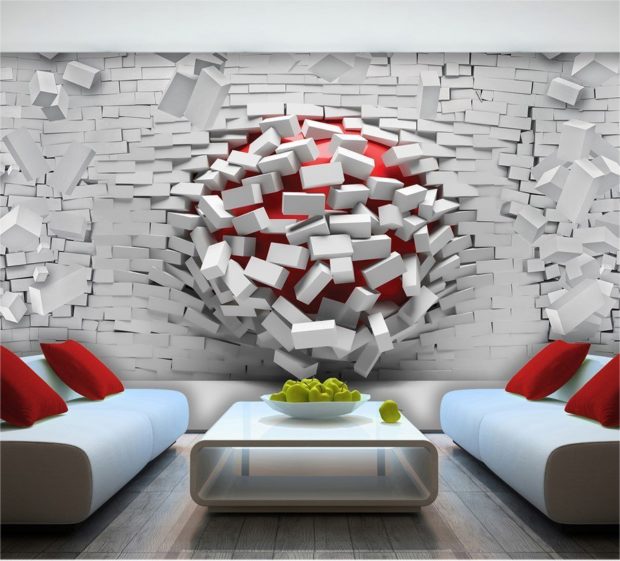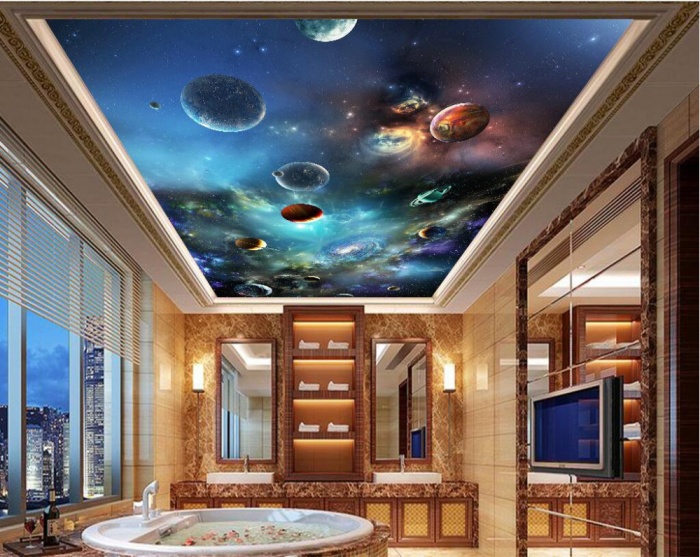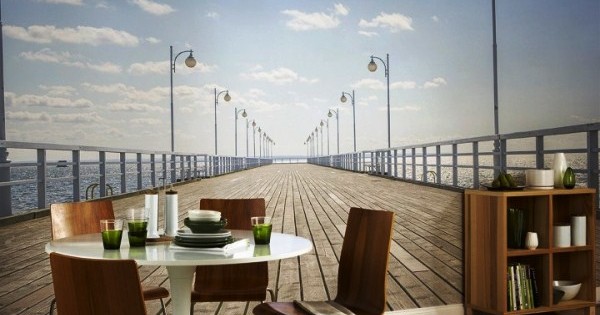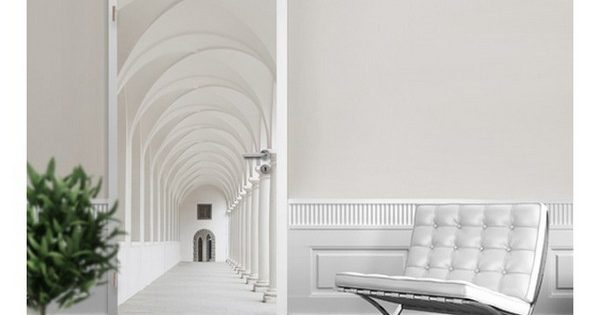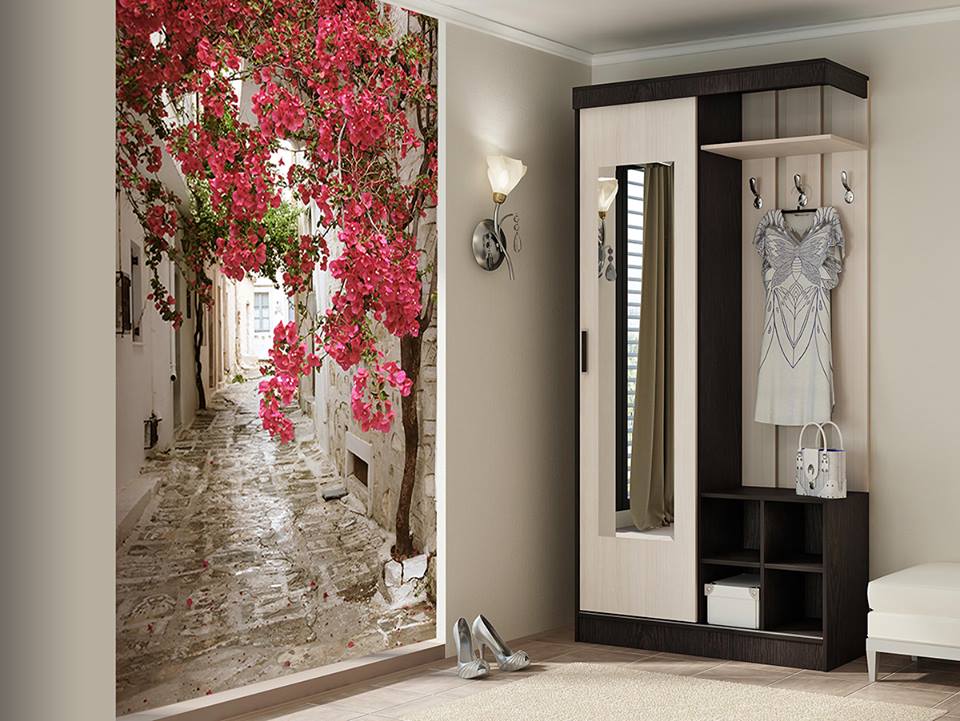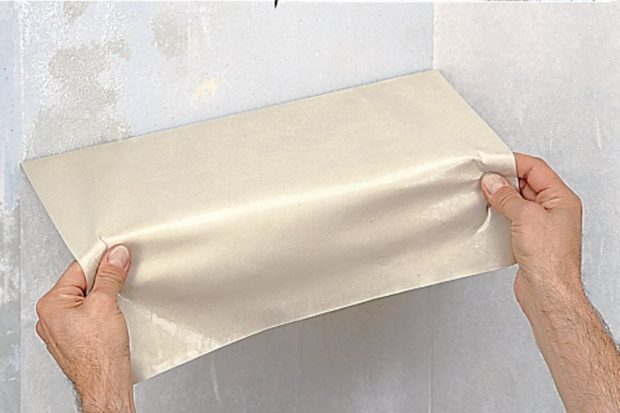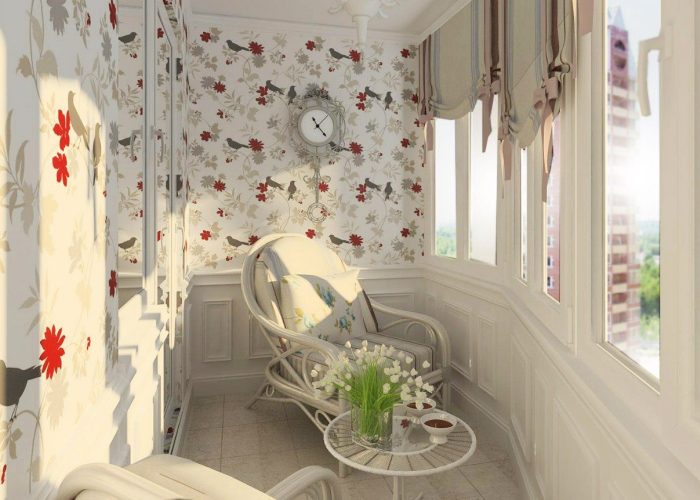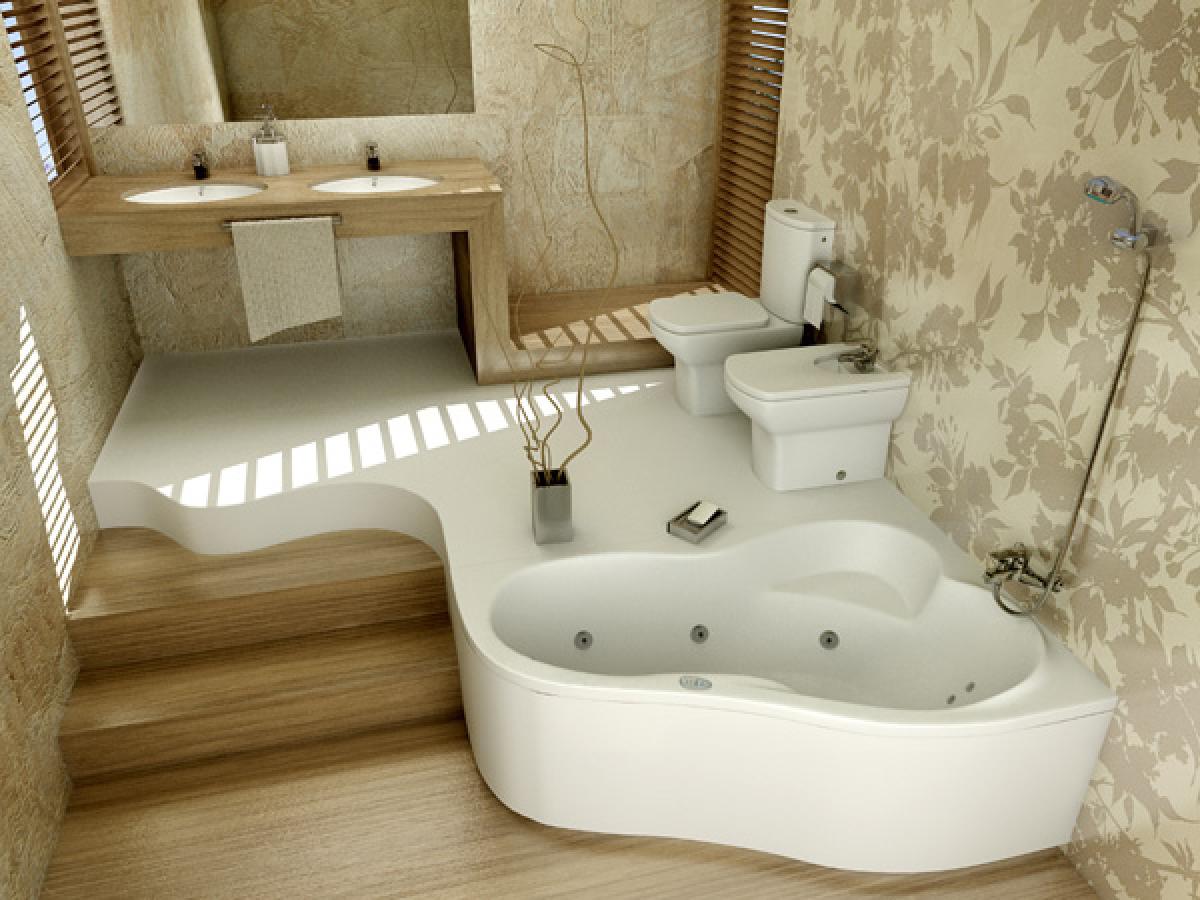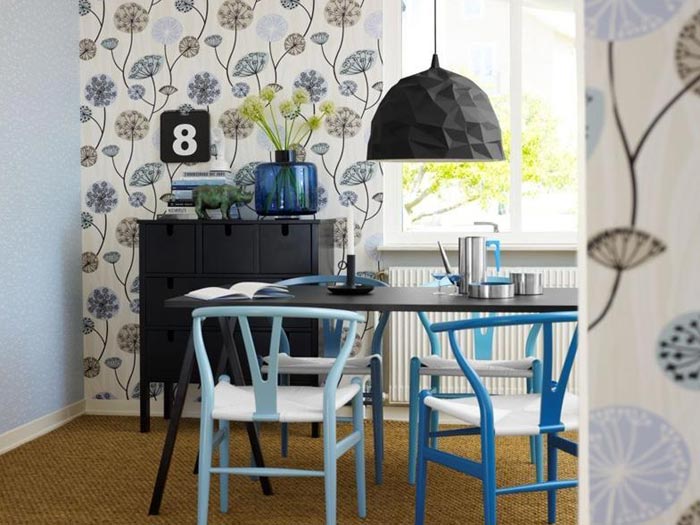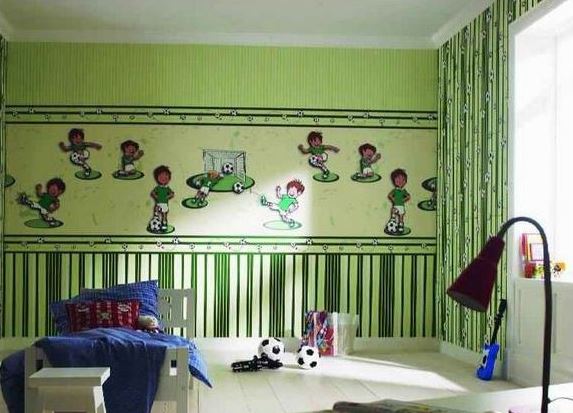Wall mural: types and sticking. How to stick photo wallpaper?
Photo wallpaper is a unique material that allows you to quickly and effectively transform a room and bring a certain atmosphere into it. Choosing the right picture of the right size is now no problem. The problem, rather, will be that from the existing choice, eyes will simply run wide. All this is complemented by the possibility of individual wallpaper production for a given picture or photograph.
Properly selected murals can quite realistically turn a living room into a piece of the coast, a house near the mountains or give the atmosphere of a cozy European cafe - depending on which plot is chosen. It is very important to choose the right picture and combine it with the interiorso as not to get the opposite effect. That is why we will dwell below on such issues as how to choose photo wallpaper, what are their main advantages and disadvantages, and, most importantly, how to stick photo wallpaper.
Advantages and disadvantages
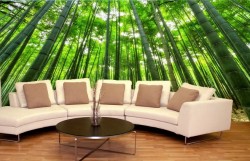 What wall murals are, of course, all represent - this is an image on paper or another basis that adheres to the wall in parts, and as a result, an integral picture is obtained on the entire wall or part thereof. Wall mural as a decoration material has a lot of advantages, the main of which are:
What wall murals are, of course, all represent - this is an image on paper or another basis that adheres to the wall in parts, and as a result, an integral picture is obtained on the entire wall or part thereof. Wall mural as a decoration material has a lot of advantages, the main of which are:
- excellent appearance - photo wallpaper can imitate any landscape, still life, convey a pattern or even a photograph, thereby reviving the room and giving it a certain mood;
- as already noted, the choice is simply huge, there is the possibility of individual orders;
- a relatively quick gluing method, as well as relative durability. So, modern murals are printed in such a way that they are practically not affected by the sun's rays, and they do not fade. Wallpaper can be glued with glue or be based on self-adhesive paper, so there is always a choice between several options. And the ability to cover the wall mural with varnish solves many issues of care and durability.
No matter how beautiful the aesthetic properties of the photo wallpaper, still without some disadvantages not done:
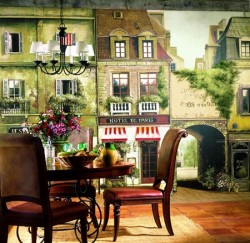
- Photowall-paper requires a perfectly flat and smooth surface - only then will they look as impressive as possible and last long;
- the process of gluing photo wallpaper, although it does not require special preparation, will still take some time, and will require attention, effort, perseverance and patience;
- some low-quality murals can peel off over time, and you will have to glue them all the time;
- and, of course, the most important thing is not to get lost with the drawing, otherwise it will bring not pleasure, but sheer irritation.
Wallpaper selection
Concerning the plot, then it would be foolish to advise anything, because everyone decorates the interior of the room at their own discretion. But some advice will still be appropriate. So, if you want to visually expand the space of a room, then it is better to choose photowall-paper of cold tones, and warm are perfect if the room does not have enough natural light. Depending on the purpose of the room, you can choose a certain topic, for example, cartoon characters - for the children's room, landscapes for the living room and something delicious - for the kitchen. Subjects and colors are important to coordinate with the interior.
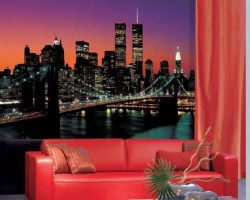 The size is selected depending on the area of the wall, and the whole picture can include from two to eight parts. It is advisable to decorate the entire wall with photowall-paper so that they are not covered by cabinets and other overall pieces of furniture. If you supplement the plot of the photo wallpaper with something in the room, it will be generally fine: for example, if the sea coast is shown there, you can put pots of palm trees right next to the wall, if there is a European street with a cafe there, you can add all this with a table and chairs in the same style etc.
The size is selected depending on the area of the wall, and the whole picture can include from two to eight parts. It is advisable to decorate the entire wall with photowall-paper so that they are not covered by cabinets and other overall pieces of furniture. If you supplement the plot of the photo wallpaper with something in the room, it will be generally fine: for example, if the sea coast is shown there, you can put pots of palm trees right next to the wall, if there is a European street with a cafe there, you can add all this with a table and chairs in the same style etc.
It is not recommended to leave the corners of the picture as if open - they should either fall just in the corner, or be covered by a frame. In some cases, murals are also supplemented with their own spotlights to enliven the picture even more, especially if it is a city landscape. Wall murals designed for the door also stand out - they consist of two parts and allow you to effectively transform the doors.
Types of photo wallpaper
Although many buyers are more focused on the appearance of photo wallpaper, it would still be useful to know how they may differ, and what they are depending on the printing method or basis.
So, when printing photo wallpaper can be used such ink:
 eco solvent ink - the most budget option, which is characterized in that the material has a specific smell, but it disappears within a day after gluing. But the presence of a smell does not mean poor quality, on the contrary, they are environmentally friendly, quite durable, resistant to ultraviolet, abrasion and washing;
eco solvent ink - the most budget option, which is characterized in that the material has a specific smell, but it disappears within a day after gluing. But the presence of a smell does not mean poor quality, on the contrary, they are environmentally friendly, quite durable, resistant to ultraviolet, abrasion and washing;- latex ink are more environmentally friendly, since they have no smell at all, do not contain harmful substances, they are recommended to be used in children's rooms. In them, pigment ink is dissolved in latex, which allows the ink to harden quickly, and as a result, immediately after printing, they are ready for gluing. They are also resistant to abrasion and fading, but have much more saturated colors and are more expensive;
- ultraviolet ink even brighter and more saturated, transmit the most natural colors. Such inks are resistant to moisture, grease, certain chemicals and the sun.
Wall murals may also differ in the type of base, and depending on this, some nuances in the method of gluing may arise. So, for photo wallpaper can be used one of the following basics:
 paper is the most common, ink is best held on it, it is environmentally friendly, easy to use, breathes, and the prices of such wallpapers are very affordable. This is an ideal option;
paper is the most common, ink is best held on it, it is environmentally friendly, easy to use, breathes, and the prices of such wallpapers are very affordable. This is an ideal option;- fabric based murals;
- non-woven, a vinyl base, but all of these options are already more expensive than a paper counterpart.
In addition, the photo wallpaper may also differ in surface type. So, the classic version is a smooth surface, but here it will be the most difficult to make the joints invisible. You can also make even more originality in your home and choose photo wallpaper with a texture for decorative plaster, coarse sand, canvas, linen, hoarfrost, etc. - it is good to use these or those options under a certain subject.
Glue the mural on the wall: the main stages
When the murals are selected or ordered, and the place for them is selected. That remains the case for small - stick them. And we will talk about the order of work and the main nuances.
Necessary tools
Sticking the murals on your own is not very difficult, but you can save a lot, and then there will be another reason for pride if the wall is decorated with your own work. So, for a start it will be necessary to stock up on all the tools:
- a tape measure, ruler or level and a pencil - in order to make markings on the wall, and wallpaper will make it easier to glue along the designated lines;
- stationery knife;
- rollers and spatulas for smoothing wallpapers;
- glue brush;
- ladder;
- clean, dry rags or sponges to remove excess glue;
- ladder;
- bucket for the preparation of glue.
 Naturally, the photo wall murals themselves come in handy.But here it’s worth making a reservation about the size: so, if you plan to finish the whole wall with them, then after making measurements, you should add allowances: to a height of 5-10 cm, and to a width of 8-10 cm, then the excess is simply cut off with an office knife . Such allowances are especially important if the walls in the apartment are not quite even, and the parallelism and perpendicularity of the walls and ceiling are slightly disturbed. If you plan to wallpaper only part of the wall, then allowances will not be needed.
Naturally, the photo wall murals themselves come in handy.But here it’s worth making a reservation about the size: so, if you plan to finish the whole wall with them, then after making measurements, you should add allowances: to a height of 5-10 cm, and to a width of 8-10 cm, then the excess is simply cut off with an office knife . Such allowances are especially important if the walls in the apartment are not quite even, and the parallelism and perpendicularity of the walls and ceiling are slightly disturbed. If you plan to wallpaper only part of the wall, then allowances will not be needed.
Wall preparation
Wall mural will look good on the wall, if it is perfectly flat and smooth, therefore, if it does not meet these requirements, then work hard on it. Firstly, if there is the remains of the old coating, then you need to get rid of them, and as carefully as possible. Remove old paint with a spatula using building hair dryer or special solvents. A spatula complete with water will also help with old wallpaper. Please note that the presence of the “spider line” grid under the photo wallpaper is unacceptable, otherwise the surface will repeat the same small fiberglass mesh over time.
 Secondly, if there are obvious defects on the surface in the form of cracks or pits, then they must be corrected with putties. Moreover, some experts recommend thoroughly filling the entire wall. Just think that even the slightest defect can soon become the reason for the formation of bubbles, peeling, seams, etc., so it’s better not to save on high-quality surface preparation.
Secondly, if there are obvious defects on the surface in the form of cracks or pits, then they must be corrected with putties. Moreover, some experts recommend thoroughly filling the entire wall. Just think that even the slightest defect can soon become the reason for the formation of bubbles, peeling, seams, etc., so it’s better not to save on high-quality surface preparation.
Thirdly, necessary primer deep penetration, it processes the walls after puttying, or, if it is not required, before gluing. It is advisable to choose antiseptic primer, but if there is no such composition, then it is better to additionally treat it with a surface.
Please note that after applying the primer, the walls should dry well, otherwise the photo wallpaper can change color in places or even peel off. And, of course, it’s good if the surface of the wall is plain and light - better than white, then nothing will block the pattern.
The finished surface must meet the following requirements: be dry, clean, smooth, slightly rough, free from dirt, grease, dust, cracks and bumps. If your wall is the same, then you did everything right, and you can proceed to the next step.
Photo wallpaper check
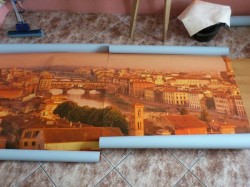 You need to check the purchased wall murals as early as possible, but in any case, before you start gluing them. It is advisable to lay out all the components on the floor, fold the whole picture and see if the picture is joined, whether the same color is used on different canvases, etc. So, it is considered a marriage if the discrepancy goes more than 3 mm, if a slightly different shade of the same element is used on different fragments, etc.
You need to check the purchased wall murals as early as possible, but in any case, before you start gluing them. It is advisable to lay out all the components on the floor, fold the whole picture and see if the picture is joined, whether the same color is used on different canvases, etc. So, it is considered a marriage if the discrepancy goes more than 3 mm, if a slightly different shade of the same element is used on different fragments, etc.
But if the color on the photo wallpaper did not coincide with what you saw on the monitor screen, then this is not considered a marriage. Keep in mind that wallpapers can still be exchanged and reprinted at the expense of the manufacturer, if you have not started gluing them - otherwise, in most cases you will have to buy a new batch by yourself.
Glue preparation
Naturally, if you purchased wallpaper on self-adhesive paper, then this section, like some others, can be skipped right away. But still, most manufacturers produce photo wallpapers that require gluing with glue, so this topic remains relevant.
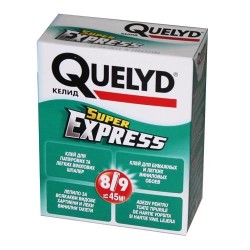 Often manufacturers supply with photo wallpaper and specific glue. It can be both ready-made and requiring preparation. In the latter case, it will need to be diluted with water of the required amount - as indicated in the instructions.
Often manufacturers supply with photo wallpaper and specific glue. It can be both ready-made and requiring preparation. In the latter case, it will need to be diluted with water of the required amount - as indicated in the instructions.
Otherwise, glue is used, which is used for heavy vinyl wallpapers, for example PUFAS, which is considered to be practically universal, and will be used for gluing non-woven, vinyl wallpapers, and glass.Quelyd glue, which is used for vinyl and textile wallpapers, is also suitable. Both the first and second glue are sold ready to use - no need to dilute with water. Also for paper-based wallpapers, Metylan glue is also suitable.
Wallpapering is best done at room temperature and humidity of about 40%.
Wallpaper Sticker
So, we pass to the most crucial step. If the wallpaper is already laid out on the floor in the correct sequence, then fine - go to the wall layout. So, for convenience, it is best to accurately mark on the wall with a pencil using a ruler and level the place where the photo wallpaper will be located, if the picture is not on the entire wall. And it’s better to use a simple pencil rather than a marker, pen or felt-tip pen. Next, with meticulous accuracy, taking into account the size of each fragment, draw a grid on the wall, according to which you will be guided when gluing. Some experts make their task a little easier and draw several strictly vertical lines, which they are guided by. If you are gluing the murals for the first time, it’s better to still draw as many lines as possible - so there’s more chance that you will get an even picture.
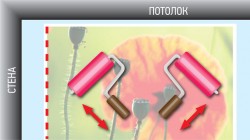 It is recommended to start gluing from the lower left corner. The prepared adhesive is applied to the wall in the place where the first fragment will be attached. Glue should not be applied to the wallpaper itself. Next, the fragment is carefully applied according to the marks and glued, starting from the top. To avoid bubbles and defects, it is recommended to use a special non-sharp spatula or a roller, which makes movements from the center to the edges, expelling excess glue and air. Excess glue is carefully removed with a cloth or sponge, preferably a little damp, but not wet. It is necessary to remove the glue from the surface of the photo wallpaper as soon as possible, otherwise it may leave stains and dry out. And you need to wipe it, and not rub the glue on the photo wallpaper.
It is recommended to start gluing from the lower left corner. The prepared adhesive is applied to the wall in the place where the first fragment will be attached. Glue should not be applied to the wallpaper itself. Next, the fragment is carefully applied according to the marks and glued, starting from the top. To avoid bubbles and defects, it is recommended to use a special non-sharp spatula or a roller, which makes movements from the center to the edges, expelling excess glue and air. Excess glue is carefully removed with a cloth or sponge, preferably a little damp, but not wet. It is necessary to remove the glue from the surface of the photo wallpaper as soon as possible, otherwise it may leave stains and dry out. And you need to wipe it, and not rub the glue on the photo wallpaper.
Wall murals can be glued overlap or butt. The recommended method will be specified by the manufacturer, and depending on this further the process is slightly different. Wallpaper that glued butt, You need to very clearly combine, and then roll the seam with a roller so that it is minimally noticeable. It’s good if you put a fairly accurate grid on the wall, as this will help you to combine fragments.
Some murals can be glued with an overlap - It is also a very convenient way. After the first canvas is glued, you also smoothly and combining the pattern, glue the second, while the edges will overlap each other. When the second fragment is already on the wall and a seam is formed, you need to use a sharp clerical knife to make a cut from top to bottom in the middle of the seam. Then the seam appears to be opened, excesses in the form of thin strips are removed, a piece of the wall is smeared with glue with a small brush, and the wallpaper is glued to the wall for good. Further, everything is the same - the seam can be smoothed with a special roller. Many note that it is in this way that you can glue the wallpaper so that the seam is almost invisible, and this is very important for texture material. With a knife you need to work clearly, but carefully so as not to damage the wall.
Further, the gluing of the fragments is continued in the same way, taking into account the method used. If the entire wall is covered by photowall-paper, and you left a small part for the allowance, then after completion of work, all residues are carefully cut with the same knife.
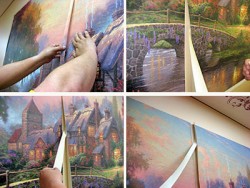 Please note that the best results can be achieved if the room is kept at the optimum temperature - 18-20 degrees, humidity and no drafts. After the pasting works are over, it is better not to ventilate the room and not to heat: such a taboo should be observed for at least 24 hours, and preferably 48 hours.
Please note that the best results can be achieved if the room is kept at the optimum temperature - 18-20 degrees, humidity and no drafts. After the pasting works are over, it is better not to ventilate the room and not to heat: such a taboo should be observed for at least 24 hours, and preferably 48 hours.
It’s necessary to devote a few words and self adhesive photo wallpaper: Many people find it easier to work with them since there’s no need to use glue.However, this technique requires a sufficiently high professionalism and preferably an assistant. After removing the paper protection, you need to work very quickly, since the adhesive layer dries and sets very quickly. At the same time, there is practically no chance to fix possible defects.
Possible defects
After a day, some defects can be found on the finished surface, although they were not there before. There may be several reasons for this.
So, most often formed bubbles, a frequent cause of which is a lack of glue, uneven smoothing of wallpaper, uneven application of a primer, as a result of which the glue simply soaked into the walls. The cause may also be temperature differences, but there is one solution - you need to try to pierce the vial with a syringe with glue and squeeze out a little, smooth it with a spatula. Wipe off excess glue with a sponge.
Wallpaper can move around the edges in the corners: the reasons may be the same as in the first case. Then you need to cut gently with a knife and once again glue the places in which they peeled off. The angle is generally a rather problematic place, and the joint here is likely to be visible.
Wall mural varnish protection
 Since photo wallpaper is still not the most reliable and resistant material, to give it more durability and a washing effect, you can use varnish, which covers the finished surface. It is recommended to use any water-based varnish. An inexpensive option is Tex Profi varnish, it is available in glossy and semi-gloss versions, it has a characteristic odor that disappears after a few hours. A more expensive option is the Multi-Brilliant Finish M LEF, which has a matte finish and is odorless.
Since photo wallpaper is still not the most reliable and resistant material, to give it more durability and a washing effect, you can use varnish, which covers the finished surface. It is recommended to use any water-based varnish. An inexpensive option is Tex Profi varnish, it is available in glossy and semi-gloss versions, it has a characteristic odor that disappears after a few hours. A more expensive option is the Multi-Brilliant Finish M LEF, which has a matte finish and is odorless.
The varnish is applied with a brush in several layers - optimally 2-3 layers. At least 1 hour should elapse between each repeated application. After the first layer has dried, rub it with a soft brush to get a small effective shine, and repeat the procedure with each subsequent layer.
In conclusion
As a rule, care for such a coating is not difficult. Wall murals can be gently wiped with a damp cloth, and if the paint has worn off somewhere, then paint on the missing fragment with a pencil. With proper care, the murals can hold out on the wall a lot, delighting the owners, well, and near the source of constant splashes and drops of fat, it is best not to use them.

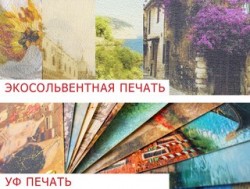
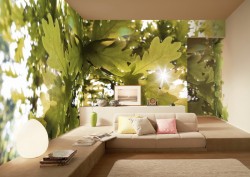 paper is the most common, ink is best held on it, it is environmentally friendly, easy to use, breathes, and the prices of such wallpapers are very affordable. This is an ideal option;
paper is the most common, ink is best held on it, it is environmentally friendly, easy to use, breathes, and the prices of such wallpapers are very affordable. This is an ideal option;
